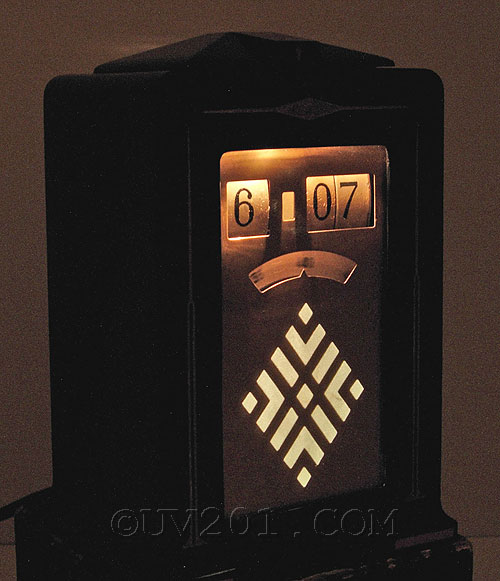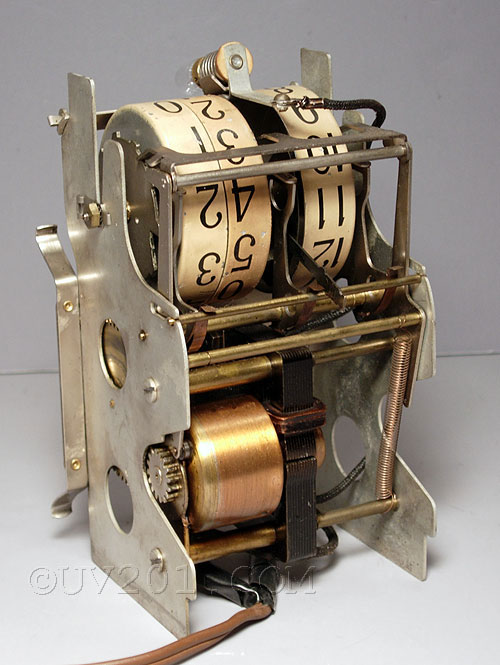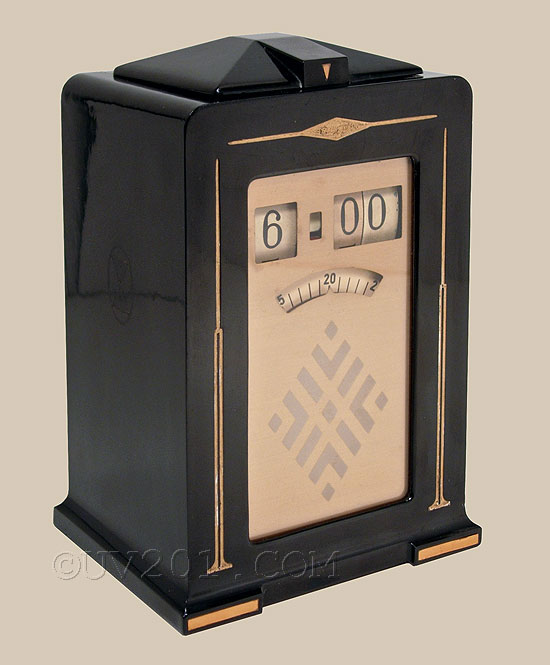|
Telechron Model 8B01 "Minitmaster" |
|
|
| The 1933-34 Telechron model
8B01 clock was known as the "Minitmaster". It was the first of a
series of clocks that were called "Cyclometers", a reference to the
three metal numeral drums that periodically rotated as the clock ran.
A constantly rotating disk at the front marked the passing of seconds.
The face of the clock was a piece of glass backed with a sheet of
lacquered brass. A decorative pattern was etched into the glass. A small bulb illuminated the drums and also caused the etched pattern to glow. A small lid at the top could be opened to set the clock, or to replace the bulb. Many of these clocks have chips and marks on the numeral drums from people using pencils or other sharp objects to turn the drums. They can easily be reached with just the fingers. Maybe people were afraid to touch the exposed bulb, but the voltage was so low that there was no danger whatsoever. Six decorative brass trim pieces were originally glued into recessed areas on the front of the case. Hourglass-shaped decorations were glued to the smooth sides. I have never seen one of these clocks with all of these decorations intact. This example has only the one small one at the top, and the two at the very bottom in place. A previous owner filled several of the recesses with gold paint. The horizontal decoration at the top was marked (embossed?) with the Telechron name. Traces of the glue which held the hourglass decorations to the sides can still be seen. |
 |
 |
 |
|
Above are front and rear views of the Cyclometer
movement. The copper-colored drum at the bottom is the actual
motor (Telechron called it a "rotor"). The pinion gear drives only
the seconds disk at the front. Between the gear and the rotor is a
cam and follower which actuates the drum drive mechanism.
The key to its operation is a piece at the top with three fingers, one for each of the drums. This can be seen just below the lamp socket. The cam causes these fingers to move forward and back and engage notched wheels that are linked to the drums. As the fingers pull back, they ride up over the high spots on the wheels, then drop down into the notches (at about 55 seconds). Then, five seconds later, as they push forward, they catch the wheels and rotate them. The sound of the fingers dropping, and then the drums rotating can be heard, but it's a rather pleasant, quiet sound. These notched wheels are of progressively smaller diameter (the hours wheel is the smallest). The minutes and tens-of-minutes wheels each have one deeper notch. When that deeper notch comes around, it allows all three of the fingers to drop down to engage additional wheels. So, every ten minutes, a deep notch on the first wheel allows the fingers to drop down to engage the second wheel. Every hour, the deep notch on the first wheel aligns with a deep notch on the second wheel, and the fingers drop down even further to engage the third wheel. The mechanism required a gap between the tens-of-minutes and hours drums. Telechron used this space to insert its signature red power failure indicator. A horizontal version of the Cyclometer movement was used in such clocks as the Telechron "Baron". |
